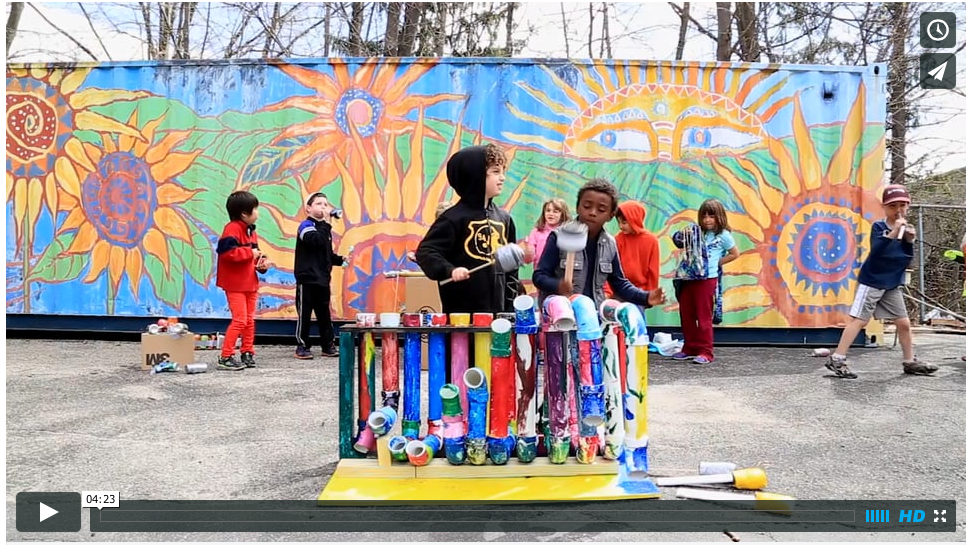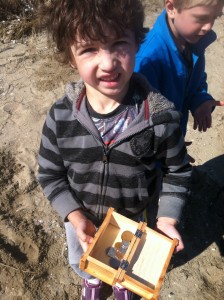We are so pleased that our KinderSTEAM partnership with the Brown/RISD STEAM club was featured in Our RISD, a place for show and tell in the RISD community! You can read it here. [su_vimeo url=”https://vimeo.com/143611780″]
Design Lab / TikkunXDesign
Mini Maker Faire
The Mini Maker Faire at Barnes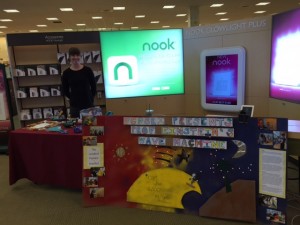 and Noble this past weekend was a success! Students in grades K-5 all had their hands on Einstein’s Wave Machine in some way. In addition to this time machine, we showcased the fourth and fifth graders’ shoe prototypes. People who stopped by our table were fascinated by what JCDSRI is up to in the design lab.
and Noble this past weekend was a success! Students in grades K-5 all had their hands on Einstein’s Wave Machine in some way. In addition to this time machine, we showcased the fourth and fifth graders’ shoe prototypes. People who stopped by our table were fascinated by what JCDSRI is up to in the design lab.
In order to make the time machine, we started by studying Einstein’s theory of time travel. Einstein thought time was an illusion, and that it depends on the speed you are traveling through space: “Einstein’s theory of special relativity says that time slows down or speeds up depending on how fast you move relative to something else. Approaching the speed of light, a person inside a spaceship would age much slower than his twin at home.” (Howell, 2013)
Children in grades K-5 partook in the effort to make a time machine. “Well, actually… no one has ever traveled faster than the speed of light!” multiple students pointed out. Instead, we used the design process to answer the question: How might we build a time machine that connects our knowledge of the design process with Einstein’s theory of time travel?
Students built a prototype that was exactly ¼ of the actual size of the wave machine. Prototyping is an imperative (and our favorite) phase of the design process. Next, students transferred everything from the prototype to the large cardboard, measured, cut, and painted. Then, we added 3D features, a pendulum, and lights. This project was also eco-friendly, in that we used solar power for the lights along with battery power and circuitry. This allowed students to connect science concepts, theoretical reasoning, circuitry, mathematics, art, and design concepts while solving the design challenge.
Congratulations to JCDSRI for being the only elementary school invited to the Mini Maker Faire of 2015! Be on the lookout for the time machine in the future, because Mr. Tilove has a master plan.
Design Lab: Constraints Drive Creativity
In Design Lab, we know what it’s like to be creative. We also know that constraints drive creativity. This means that when we have a limited amount of resources and time, we have to be extra creative in utilizing what we have. Additionally, the mantra “fail fast, forward” drives us to learn from what may not have been so successful, and to move onto bigger and better things.
Today in Design Lab grades 3-5 worked together in small groups to make towers out of newspaper. While they were able to use a very small amount of tape, newspaper was the primary material that students could use. By working together, students were able to brainstorm and implement their ideas cooperatively. You might be surprised to learn that they were able to make some amazing, creative, and innovative free standing structures out of the otherwise very flimsy material. “All the tape in the world” may have created more successful structures… but look what we made!
Let’s Design!
In order to create a useful product, designers need to understand how a user(s) feels about an object, system, or space. Therefore, our classes all started with empathy.
In third grade, we learned about empathy by taking part in a “leading the blind” activity. While one student was blindfolded, his or her partner led him or her across the room (without touching or redirecting!) to perform a very specific task. While blindfolded, each student needed to pick up a cylinder from across the room, turn around, go through a set of doors, and place the cylinder on a small table. Then, students switched roles. To conclude the activity, we talked about how it felt to be the person who was blindfolded, and how it felt to be the person who was leading. Thus, we learned that empathy is understanding how someone else feels.
The design thinking process also involves creativity! First, we explored what creativity is. In first grade, we used straws, sticky tabs, and paper clips to create anything that we wanted. We quickly realized that we had to utilize our creative juices to make many different things from the limited resources.
Work in progress:
PreK and Kindergarten students are learning about how everyone is creative, especially the bunny in Not A Box by Antoinette Portis!
We’re thinking about the question: How might second graders create time capsules so that they can feel surprised, happy, proud, and different when they open it a year later?
And finally: How might the fourth and fifth grade students improve the fourth grade meeting spot so that it is comfortable, inviting, spacious yet cozy, and promotes conversation?
JCDSRI Featured in East Side Monthly Magazine
The Jewish Community Day School of Rhode Island was featured in this month’s issue of East Side Monthly. Read about our Design Lab, Design thinking, STEAM week and our focus on creativity and collaboration in the June issue.
Field Trip to RRIE
By Eliora, the 5th grader:
On Wednesday our class went to the recycling center. We went there not knowing anything that we wanted to buy, and left with everybody carrying at least one heavy bag (including Mrs. Woods and Peter.) We got so many materials that we will reuse in our sculpture. Our class got started on an abstract sculpture right away, and I was the official bottle cap holer (I put holes in the bottle caps.) We have wind chimes, bird feeders, and pots for plants on what looks like a plastic cupcake holder. In conclusion, we all had an amazing time collaborating this week.
Curious to know more about where we went? Click here: http://www.rrie.org/


Discoveries at the Beach!
As part of our STEAM week learning – and in celebration of Earth Day – we went this morning to Conimicut Beach in Warwick, RI to see the lighthouse (a historic sparkplug lighthouse built in 1883) and go on a treasure hunt!
When we first arrived at the beach, we unfurled the treasure maps that our amazing friend and teacher, Peter, had created for us.
After locating the “x marks the spot” on our maps, we went searching (and digging!) on the beach for our buried treasures . . . .
. . . and we knew when our friends had found their treasure chests when we suddenly heard squeals of delight!
When we opened them, we discovered they were filled with pirate coins!
Afterward, we went exploring on the beach.
We discovered beautiful shells, driftwood, and even helped to carry a horseshoe crab back to the water (yes, that’s a picture of the children gently holding the crab by the tail!)
At the end of our adventure, we stopped together by the water and sang our morning blessings as a kehillah. As we watched the waves roll over the sand at our feet and listened to the gulls sing above us, we ended with a special prayer of gratitude (the shech’iyanoo).
Thank you so much, Peter, for creating such an exciting adventure for us. And thank you, Val (Aeden’s mom) for joining us!
Math Rope Trick Workshop
By Jonah the Fifth Grader:
We the fifth graders, recently had a math workshop done by Ken, a Brown PhD Candidate. We learned about different ways to get from one to negative one. Ken showed this visually by having four of us at a time hold two ropes parallel to each other. Then we twisted the rope into a knot, and we untangled it without undoing what we did or just using our hands at the middle of the rope. The main objective was to untangle the ropes using an algorithm.
We learned all about negative reciprocals and how they work. We used fractions, negatives, and positives. I think that we all had a lot of fun doing this workshop and learned from it. We learned that when the knots are untangled the starting number is zero. When it is tangled we had to try to get back to zero. Twisting the ropes once increases the number by one, and rotating the ropes changes the number to its negative reciprocal. We learned that the algorithm we used was the only one in the world that has currently been discovered. Overall this workshop was extremely well done.

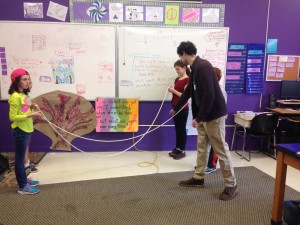
What’s Happening in Design Lab?
You might be wondering what’s been going on in our much talked about design lab. Based on student motivation, developmental ability, and classroom-connections, projects will look quite different from grade to grade. Here is a taste of some of the projects we have been working on most recently:
For the 100th day of school, kindergarteners worked to create the tallest structures they could using 100 toothpicks and 100 marshmallows. They noticed what shapes are structurally stronger than others. They also realized that sometimes you need to start a project over again in order to do it better the next time. Mistakes are what help you get better!





First graders have been learning about simple machines. They have been introduced to levers, pulleys, and wedges. Students experimented with all three of these machines then were tasked with the following challenge: Create an invention using at least one of these simple machines that could help someone with a problem. They have come up with some fascinating tools!



Check out a video of one student’s creation here:
2015-03-13 11.22.14 from Jewish Community Day School RI on Vimeo.
Second graders have been studying balance and motion and have created various tools and inventions such as musical instruments, cars, and marble coasters.
Third graders have been creating digital content to go along with their fantasy stories that they wrote with Mrs. Davis. They have learned how to navigate between apps, to pull pictures from the internet, and to record their voices in order to create powerful digital content. Soon you will see their work in the hallway near the computer lab. Please download a QR code viewer on your mobile device to be able to watch their projects.


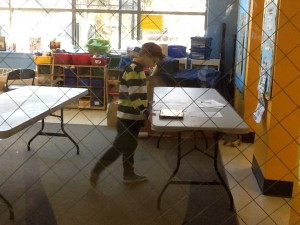
Fourth and Fifth graders have been tirelessly working to create a Rube Goldberg machine. They have learned so much about creating ideas, testing, making mistakes, and trying again. Their grit and tenacity has been apparent as they tirelessly strive to make a successful machine. Stay tuned for the final video.
Here is one student talking about the process of creating the Rube Goldberg:
2015-03-16 14.02.15 from Jewish Community Day School RI on Vimeo.
STEM Labs vs. STEAM Labs vs. MakerSpaces vs Design Labs: Whats the difference?
If you have been paying attention to educational buzzwords recently, you may have noticed a slow migration of thought. First, we were obsessed with STEM (Science, Technology, Engineering, and Math). Then we moved from STEM to STEAM, adding an A for the Arts to humanize the purely scientific study of STEM. This initiative was led by our partners and neighbors at the Rhode Island School of Design (RISD). Many schools and universities are rebranding their STEM labs STEAM labs and beginning to incorporate art and the esthetics into their engineering and technology projects.
You may have also noticed the advent of Makerspaces. The Maker movement is akin to a 21 century do-it-yourself shop class. People use the new tools of the trade – Arduino motherboards, 3D printers, vinyl cutters, and soldering irons. The Maker movement is about creating with technology- not just buying it. Makers make their own cameras, musical instruments, computer tablets, drones and artificial limbs. It is an exciting way of mastering and welding technology that puts the power of curiosity, ingenuity, and initiative into the hands of everyone who wants to create.
Makerspaces are springing up all over the place-even in k-12 and elementary schools. At the National Association of Independent Schools annual conference, held last week in Boston, 25 schools from across the country submitted their school’s Maker Spaces to a gallery for all to observe (JCSDRI was one of them: Check out the NAIS Makerspace website here:)
The newest related buzzword is Design Thinking. Design Thinking is essentially a way of looking at needs, problems, and solutions by putting people and values first. It is ‘human centered’ and based primarily on empathy. The first role of the Designer is to observe, ask questions, understand the user’s needs and values, and the ‘make.’ The key mindsets of Design Thinking are a bias towards action, people above products, radical collaboration, rapid prototyping, and failing fast forward. Design thinking is about ‘how’ we think, before addressing content or skills.
We at JCDSRI love the STEAM movement (click here to learn more about our amazing relationship with Brown/RISD STEAM) and the Maker movement, but we are proud that what we have created is a DESIGN Lab. Design starts with values, empathy, and understanding. These core human skills – asking, listening, observing, and empathizing are part of our Jewish and educational mission.
Tags: K12, education, design, STEM, STEAM, Brown, RISD, kinderSTEAM,
